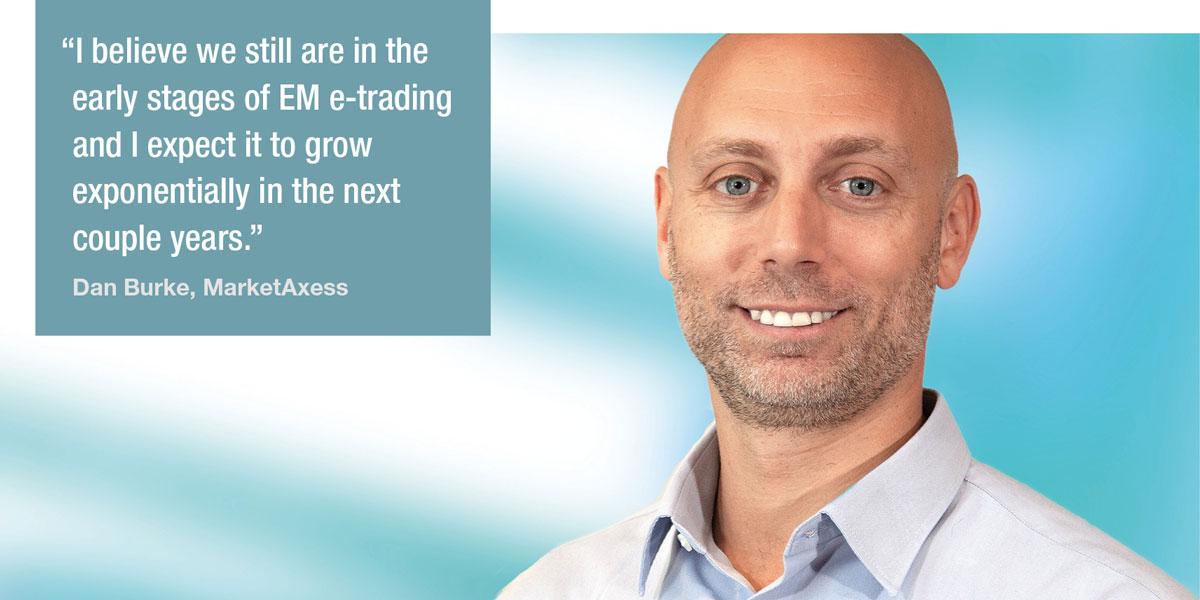The friction of trading across a fragmented emerging market landscape is being drastically cut, says Dan Burke, MarketAxess.
The DESK spoke with Dan Burke, who has joined MarketAxess as global head of emerging markets, after more than two decades of sell-side experience in emerging markets debt trading. He explains how the network effect delivered by trading platforms has been reducing the cost of liquidity and optimising pre-trade market information, thanks to engagement with both dealers and buy-side trading desks.
Tell us about your journey and how you ended up at MarketAxess
I’ve spent 20 years working within emerging markets (EM) across multiple locales, including Tokyo, Hong Kong, Singapore, and most recently, London. I have been familiar with MarketAxess throughout my entire EM career and have been a client of the platform for 21 years. Joining the team at MarketAxess felt like a natural next step in my career – especially given their long history of innovation, which is something that’s very important to me.
Back in my days on the retail trading desk, I had to pick up the phone for every interaction, for even the smallest denomination. MarketAxess has revolutionised the market and ultimately made it much more efficient. When I think about software at work, I compare it to the apps we use every day on our phones. You don’t necessarily think–or want to think–about everything that goes into making the app, you just think about the end result and hopefully the ease of getting there. Looking back on my time on the retail desk always on the phone, I can zoom out and see all that MarketAxess has done and how it changed so much of what I knew when I first entered this market.
What are the benefits of coming into this role with a dealer background?
In the past, it felt like dealers sometimes had less of a voice when compared to clients. I plan to leverage my knowledge and industry skills from that time and change this perspective. MarketAxess delivers protocols and functionality that benefit the entire market ecosystem, not just the end-users. I’m looking at my past as a dealer as an advantage.
Dealers are just as important as clients in the bond trading ecosystem – it’s always been a symbiotic relationship. I think a good example of this is seen in block trades. I want to be able to provide dealers with a huge level of comfort based on my experience of how to make bigger trades. With this will come less information leakage and all around efficiencies within the dealer ecosystem.
Where do you see the future of EM e-trading heading?
I believe we still are in the early stages of EM e-trading and I expect it to grow exponentially in the next couple years. MarketAxess will spearhead this change as a growing asset class, and one that is increasingly in-demand from our clients. I believe we will see more tradable jurisdictions, better execution, and increased automation across the board for all market participants. Right now, we are just scratching the surface. Latin America and the Middle East are two massive markets that still are in their infancy in terms of EM e-trading, and I expect these regions to grow and become even more desirable markets for clients and dealers.
There has always been a perception that emerging markets lacked adequate liquidity to be priced by algorithms – this is poised to change. We are currently seeing a shift in price formation with the increase in quality of data, primarily from CP+. Pricing systems are becoming more robust and adding immense value during periods of peak volatility. But the increasing quality of data means that we are finally at a shift away from manual hand pricing and into algorithmic pricing.
What protocols are essential in EM?
As someone who has used these protocols on a daily basis for more than 20 years, I can wholeheartedly say that RFQ and Open Trading were game changers within the EM space. And now, with the addition of Request-for-Market (RFM) and Portfolio Trading, MarketAxess has yet again upped the ante. Under my leadership, I plan to market these protocols even further so that all clients recognise just how powerful these tools are.
Most people associate MarketAxess with its Open Trading network, which is unlike any other I’ve seen on the market. But I think it’s important for everyone to know that not every ticket goes to Open Trading. One thing that doesn’t get as much attention that I think is incredible at MarketAxess is its vast network. The EM platform alone has more than 1,600 participants in more than 120 countries. Through this network, the RFM offering also provides unrivalled pricing in size in a way that protects both the client and the dealer. We have dealers in every jurisdiction for local markets access – currently with 26 local markets represented. We have pockets of liquidity from all over the world and it’s growing. Just recently, we added Casada, the Brazilian debt instrument, to the platform. With this addition, MarketAxess now offers the complete range of Brazilian sovereign debt products, including LFTs, LTNs, NTN-Fs and NTN-Bs. 
www.marketaxess.com
©Markets Media Europe 2024
©Markets Media Europe 2025













